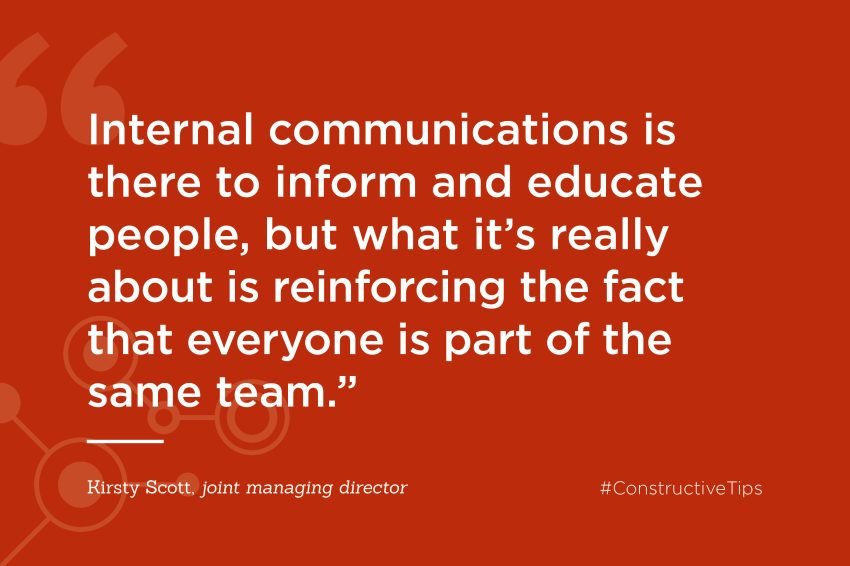People power: why your team hold the key to unlocking your internal comms potential
Published - 28th February 2023

When we hosted our recent values day, one phrase came up again and again: ‘people centric approach’.
At Harris Creative, we’re fortunate in that people are at the heart of all our policies, and all of our internal comms. With a small and close-knit team like ours, working together on multi-service projects every day of the week, it’s certainly easier to put our colleagues first.
But how do you scale that people-centric approach up and apply it across a company 1,000 times bigger than ours? And where the experience of work can vary enormously between different job roles and locations? That’s the challenge facing internal communications teams across the construction industry.
Who are you talking to?
Internal communications appears to present a unique challenge: how to keep staff from all parts of the business equally well-informed and engaged, when they are performing different roles and have different priorities.
This is even more tricky for construction companies, where staff can be based in an office, in their vehicle, on-site, or on a factory floor. Does a machine operative need the same information as a bid director? And how can you reach a HGV driver and a desk-based sales rep with the same information on the same day?
It’s easy to become embroiled in the minutiae of the problems facing effective internal comms, so it’s useful to take a step back and consider the true purpose of your messaging. Internal communications is there to inform and educate people, but what it’s really about is reinforcing the fact that everyone is part of the same team. If you consider colleagues as people with a true stake in the company, it may help to shift your thinking.
If we consider all staff to be key stakeholders, we can see the value in including them in the conversation, and the company is incentivised to keep the comms flowing in a way that works for everyone. This may mean tailoring your approach – so as well as publishing important updates or all-staff training on an intranet, maybe factory staff need additional signposting such as posters to remind them to log on when they next get a break? It’s important to tailor the delivery method, as well as the message, so that everyone feels included.
Keeping comms personal
The delivery method is essential in ensuring that the message gets through: ideal for informing people, but what about engaging with them?
Real engagement means using your internal comms as more than a one-way channel, providing a medium through which voices from across the business can be heard and amplified. Internal comms that is purely top-down does little to connect with employees, and is more likely to become something that people tune out.
By including all staff in your communications as contributors as well as recipients you will enliven the whole process: if your people believe that they are being listened to about their day to day lives, they’re more likely to speak up when they encounter an issue.
So internal comms has to go beyond a series of emails or intranet articles written in a distant head office: it has to include, where possible, inclusive and interactive elements, like virtual coffee mornings or company wide breakfast breaks.
And encourage people to come forward with their ideas too – the people in your company know their own challenges better than anyone, and can often be impressively creative in how they overcome them. If someone has come up with a great initiative, whether that’s a way to save their colleagues time, a mental wellbeing policy like walking meetings, or something that adds value for customers, your internal comms needs to shine a spotlight on that.
Colleagues are consumers too
Thanks to social media and digital marketing, the lines between internal and external comms have blurred. We have to remember that every internal message is just a couple of clicks away from being shared outside of your organisation: after all, we’ve all seen screenshots of poorly worded internal emails doing the rounds on social media! That means it’s essential that your internal channels not only strike the right tone, but work in tandem with your external messaging.
Equally, companies need to understand that their employees are media consumers too, and will be likely to keep abreast of what you’re saying to the outside world, whether on social media or through tools like Google Alerts.
That’s why it’s important to keep your internal and external channels closely aligned, in tone and in content. Your team will see what you are putting out into the world, and if it doesn’t match their experience of working with your business, it can create discontent. As an example, when an external announcement boasts about investment, but internal messaging warns of cost-cutting, the dissonance can be very damaging.
Having a marketing team that works closely across both external and internal communications helps a great deal, and if you are working with an agency for your outward-facing marketing, make sure they’re aware of internal comms too – even if that’s as simple as including them on your all-company emails.
Increasingly, internal and external marketing overlaps – but if used well, and if your people are at the heart of everything you do, internal communications can be a powerful tool to support your business’s growth.
Harris »